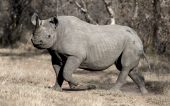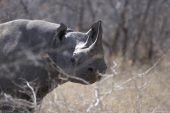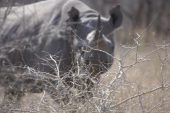Horst gored by Rhino
True to form Horst (who contributed greatly to the ambience in the Explorers Club) has run into an ambush; a rather large grey aggressive one, while he was photographing it. Luckily he is back on his feet, after some rather nasty surgery to his rear, and full of beans after some care from Anne and much gnashing of teeth! It could have been a lot worse as you can read in the full story below. Horst was very lucky but it will add to his bank of close shaves. As always he takes it in his stride, although this time his stride was not big enough to avoid the hole that got him into this mess!.
Full story here….By Christopher Munnion
For most of his life, Horst Klemm, acclaimed international photographer, has been an adventurer, seeking challenges in the remotest corners of the world and pitting his wits and skills against man and beast and surviving otherwise life-threatening situations.
He will admit that the narrowest escape from death he has ever experienced came in his own beloved Africa when he was attacked by a black rhino named Richard in August, 2009. Richard attacked at speed, tossing Horst at least 15 feet in the air and causing severe injuries. Had the animal pressed the attack, Horst would have died.
I was surprised when I heard of the attack as I have spent many months with Horst Klemm in the African bush and have admired his skills in “reading” the behaviour of any given wild animal before he sets up his photograph. He knows, for instance, when an elephant bull is in musth and likely to react aggressively to his presence. He has spent years working in the African wild and has finely tuned his bushcraft.
When I visited him in hospital in Pretoria shortly after his encounter with Richard the rhino, I suggested that he might like to put his experience on record. It might help others who encounter black rhino in the wild to avoid a similar – or worse – fate. When he had recovered sufficiently at his home in Cape Town, he wrote the following:
“On foot and armed with a camera, I am a soft-shelled target for sudden aggression, very aware of being a trespasser in the territory of powerful and quick-tempered Ric hard, an East African black rhino about to be returned to the Serengeti. Collecting reference material for the production of a bronze sculpture, Richard the Rhino attacked me in August 2009. His well-developed sense of smell and hearing detected me too soon and gave me little chance to reach my hiding place.
“Saliva snorting Richard moved his 2.5 ton massive bulk in a burst of surprising speed. I stumbled in a hole in the ground and lost my footing and the camera. A split-second later, I found myself flying very high through the air short of my life-saving trees. On landing, I broke my left upper thigh and had a huge, gaping wound on my right backside. Lying on my back, camera to my right and my leg 90 degrees to the left, all I knew then was situation. The rhino was gone”
A typically laconic Klemm account but I felt the episode deserved far more background on how Horst and Richard came together in the first place as well as a far more detailed account from Horst himself of the attack and its aftermath.
Richard, it transpired, is almost as famous in rhino conservation circles as Horst Klemm is in the photographic world. He is the top stud of an ambitious venture to repopulate Tanzania’s renowned Serengeti reserve with the highly-endangered sub species of black rhino, Diceros bicornis michaeli, found only in the Serengeti and Ngorogoro Crater regions of East Africa.
The black rhino was once abundant not only in East Africa but in other African regions. In 1970, it was estimated that there were some 60,000 black rhino in Africa but uncontrolled poaching reduced the species to fewer than 2,300 by 1993. Poaching gangs were well-armed and organized by agents in the Middle East and Asia to satisfy the demand for ceremonial dagger handles, traditional medication and aphrodisiacs. Game wardens were at that stage not equipped to counter the threat.
One night in August, 1995, gunfire was heard in the Ngorogoro Crater south of the Serengeti. A search party of wardens ventured out at first light and came across an all-too-familiar dreadful sight: the butchered remains of a female black rhino, her horn having been brutally removed.
An orphaned eight-month-old calf – a young bull later to be named Richard – was found wandering around the area a few kilometres away. He was too small to be survive without his mother’s milk and incapable of defending himself against the many predators in the region. It was essential that he be rescued immediately and taken to a place of safety.
With no qualified vet or immobilization equipment available, the baby bull had to be captured manually. Two attempts failed and only on the third try was Little Richard restrained and taken into “protective custody”. Wardens noted that the baby rhino had already been attacked by lions as there were deep scratch marks on his rump and back.
A German businessman and passionate conservationist agreed to build a boma on his coffee plantation near Arusha where he had a wildlife sanctuary. The traumatized little rhino was transported to this sanctuary where he was tended and looked after for two years. He had a happy two years here, hand-fed and loved by the children of the ranger who had found him.
As he started to grow, conservation groups in conjunction with the Frankfort Zoological Society, agreed that the rhino (named ‘Richard’ by the children at the sanctuary) should have as little human contact as possible in order to keep him wild. Richard had already been identified as a bull that could help to breed and revive his sub-species of black rhino.
Under an agreement between the Tanzanian and South African governments, a swap was arranged between national parks. Richard and another black rhino bull were exchanged for two southern females and went to live in the Addo Elephant National Park in the Eastern Cape. In his eleven years there, Richard was introduced to other black rhino of the michaeli sub-species and successfully fathered several offspring.
In recent years, Richard and other black rhinos of the East African species have been relocated to a vast private reserve in the bushveld of South Africa’s northern province. The move was aimed to prevent any cross-breeding with other rhino species and as a prelude to a massive operation to relocate them to Tanzania.
From November this year to April 2010 some 32 black rhinos will be flown to the Serengeti and eventually released back into the wild. Each will have a microchip implanted into their horn so they can be monitored around the clock. The anti-poaching patrols and operations in the entire Serengeti-Ngorogoro region have, in the meantime, been greatly expanded and improved and the authorities are confident that the rhino can be protected at all times.
The relocation will be timed to coincide with the 50th anniversary in 2010 of the proclamation of the Serengeti as a reserve. The return of the reserve’s flagship species -a viable breeding herd of Diceros bicornis michaeli to their homeland- is the highlight of the celebrations and the now-legendary bull, Richard, will be among the first to be released.
TANAPA, the Tanzanian National Parks authority, will be commissioning a bronze statue of Richard and to assist the sculptor detailed photographs of the rhino are needed. Who better to obtain such photographs than one of Africa’s most acclaimed wildlife photographers, Horst Klemm.
Horst traveled to the reserve in Limpopo Province, setting aside a few days to track Richard and take the shots he knew the sculptor would need – detailed close-ups. With two trackers, he finally located the rhino. Fully aware that the black rhino is more bad-tempered and faster on its feet than its white cousin, he was cautious and patient and finally rewarded with some excellent close-ups of the big bull.
Always a perfectionist, Horst decided to try for even better shots on the second day. Again he set off with the two trackers, neither of them armed, and again they found Richard on the edge of a thicket. The rhino moved into the open and they followed. Leaving the trackers on the vehicle, Horst moved towards the rhino on foot. “I was very cautious and made sure that I was always in easy reach of a quick refuge,” he recalled.
In this case, the refuge was a clump of three trees he could hide behind or climb. He was within ten yards of the trees and a good thirty yards from the rhino. “Richard seemed to be interested in the trackers in the vehicle and I started shooting. Then he suddenly turned his head in my direction and I sensed it was time to get to my trees,” said Horst.
“I started running the short distance, aware that the rhino was now charging me. Suddenly my foot caught in a depression and I stumbled, losing my camera. I could hear the snorts as he galloped towards me at amazing speed. As I got to my feet I felt this massive blow to my back side and I was airborne.
“I remember seeing flashes of the sky as I turned at least three times in the air and then I landed on my back with a great thump. My leg was at 90 degrees to my body and I had this huge gaping wound in my right buttock. My first concern was that Richard would return to finish me off but fortunately he did not. I reached up and grabbed a bush, trying to pull my leg back into the right position. It all happened in a matter of seconds. I was within a foot or so from my trees”
The trackers ran to where Horst lay and assured him that the rhino had vanished. When they found it impossible to lift him, they radioed the farm manager who arrived quickly with more staff members. They produced a long jack-handle to act as a splint and, as Horst was bleeding profusely, checked to ensure no artery had been punctured. Eventually they managed to get him aboard a small helicopter used for game spotting and he was flown to the nearest hospital in a small northern town.
There he was given basic treatment and told he would have to be transported to the nearest fully-equipped hospital which was in Pretoria. Horst then had to endure an agonizing three-hour journey in an ambulance, much of it over bumpy dirt roads. “I know just how lucky I was to have survived the attack” he said. “The doctors told me that if the rhino’s horn had pierced me an inch or so either side it could have been fatal.”
Horst is now making a good recovery and hopes to be able to do without his crutches soon. Does he hold a grudge against Richard? “Not at all,” he laughs “He’s my buddy. He was doing what any good rhino would do when he suspects a threat. Good luck to him!” When Richard is eventually released back into the place of his birth, Horst hopes to be there – to photograph him.




1 Comment
Join the discussion and tell us your opinion.
I have just met Mr Klemm at a community braai in White river, he told me the story about Richard and I have just read it again. Wow what a fantastic guy and a jaw dropping story. You made my night. I hope I can catch up with you again so you can
tell me more. All the best. Regards Rob. Be safe!